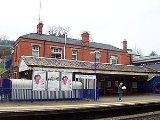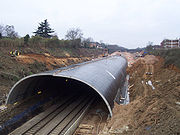
Gerrards Cross railway station
Encyclopedia
Gerrards Cross railway station serves the villages of Gerrards Cross
and Chalfont St Peter
in Buckinghamshire
. It is in a cutting on the Chiltern Main Line
between and .
It provides fast rail access to and to and . Although its name has long been merely "Gerrards Cross", its original name was "Gerrards Cross for the Chalfonts". A single weekday service to starts at the station, arriving in London at 1043 hrs (as of July 2008), running non-stop from . It traverses the rarely-used former main line between Northolt Park Junction and Old Oak Common Junction, in many places reduced to a single track. This section is used more frequently by freight and waste trains, and also diversions during engineering works. There is an equivalent service from Paddington departing there at 1112 hrs, which runs non-stop to Gerrards Cross, but this train terminates some way to the north at .
in the first decade of the 20th century, and opened in April 1906, along with many other stations on the line. The cutting is particularly deep in order for the railway to meet the gradient profile requirements of the line, which defined a very shallow maximum gradient to allow for fast running with steam-hauled trains. The original station layout was four track, with two through roads and two platform roads. A small goods yard lay to the north of the line. This has now gone, but services from Marylebone that terminate at Gerrards Cross use the siding there.
The new line and station virtually created the present Gerrards Cross; the original settlement lay for the most part along the Oxford Road.
The station was transferred from the Western Region of British Railways to the London Midland Region
on 24 March 1974.
In October 2007 work began on installing ticket barriers, these became operational on Monday 10 March 2008.
supermarket chain is turning the cutting on the London side of the station into a tunnel
by the use of large concrete ring segments to form the tunnel profile. The space on top of these segments is to be filled in to form a ground surface on which the new supermarket can be constructed. Many of the town's residents do not view this development with favour.

A Marylebone-bound train was standing at the eastbound platform at the moment of collapse. Its driver saw the collapse and raised the alarm, so all traffic stopped. No one was injured. A westbound train that had left Denham had to make an emergency stop between stations and go back to Denham Golf Club to allow its passengers to alight. Again, no one was injured.
Gerrards Cross railway station had its centenary year in 2006. This was celebrated by running steam locomotives 48151 and 5690 Leander between Marylebone and High Wycombe.
Gerrards Cross
Gerrards Cross is a village in Buckinghamshire, England. It is in the south of the county, near the border with Greater London, south of Chalfont St Peter. Gerrards Cross is also a civil parish within South Bucks district, which was known as the Beaconsfield district from 1974 to 1980...
and Chalfont St Peter
Chalfont St Peter
Chalfont St Peter is a village and civil parish in Chiltern district in south-east Buckinghamshire, England. It is in a group of villages called The Chalfonts which also includes Chalfont St Giles and Little Chalfont. The villages lie between High Wycombe and Rickmansworth. Chalfont St Peter is...
in Buckinghamshire
Buckinghamshire
Buckinghamshire is a ceremonial and non-metropolitan home county in South East England. The county town is Aylesbury, the largest town in the ceremonial county is Milton Keynes and largest town in the non-metropolitan county is High Wycombe....
. It is in a cutting on the Chiltern Main Line
Chiltern Main Line
The Chiltern Main Line is an inter-urban, regional and commuter railway, part of the British railway system. It links London and Birmingham on a 112-mile route via the towns of High Wycombe, Banbury, and Leamington Spa...
between and .
It provides fast rail access to and to and . Although its name has long been merely "Gerrards Cross", its original name was "Gerrards Cross for the Chalfonts". A single weekday service to starts at the station, arriving in London at 1043 hrs (as of July 2008), running non-stop from . It traverses the rarely-used former main line between Northolt Park Junction and Old Oak Common Junction, in many places reduced to a single track. This section is used more frequently by freight and waste trains, and also diversions during engineering works. There is an equivalent service from Paddington departing there at 1112 hrs, which runs non-stop to Gerrards Cross, but this train terminates some way to the north at .
History
The station was built as part of the Great Western and Great Central Joint RailwayGreat Western and Great Central Joint Railway
The Great Western and Great Central Joint Railway was a joint venture supported by the Great Western Railway and Great Central Railway and run by the Great Western and Great Central Joint Committee. The original arrangement was agreed between the two companies in September 1898...
in the first decade of the 20th century, and opened in April 1906, along with many other stations on the line. The cutting is particularly deep in order for the railway to meet the gradient profile requirements of the line, which defined a very shallow maximum gradient to allow for fast running with steam-hauled trains. The original station layout was four track, with two through roads and two platform roads. A small goods yard lay to the north of the line. This has now gone, but services from Marylebone that terminate at Gerrards Cross use the siding there.
The new line and station virtually created the present Gerrards Cross; the original settlement lay for the most part along the Oxford Road.
The station was transferred from the Western Region of British Railways to the London Midland Region
London Midland Region of British Railways
The London Midland Region was one of the six regions created on the formation of the nationalised British Railways and consisted of ex-London, Midland and Scottish Railway lines in England and Wales. The region was managed first from buildings adjacent to Euston Station and later from Stanier...
on 24 March 1974.
In October 2007 work began on installing ticket barriers, these became operational on Monday 10 March 2008.
Tunnel works
A development by the TescoTesco
Tesco plc is a global grocery and general merchandise retailer headquartered in Cheshunt, United Kingdom. It is the third-largest retailer in the world measured by revenues and the second-largest measured by profits...
supermarket chain is turning the cutting on the London side of the station into a tunnel
Tunnel
A tunnel is an underground passageway, completely enclosed except for openings for egress, commonly at each end.A tunnel may be for foot or vehicular road traffic, for rail traffic, or for a canal. Some tunnels are aqueducts to supply water for consumption or for hydroelectric stations or are sewers...
by the use of large concrete ring segments to form the tunnel profile. The space on top of these segments is to be filled in to form a ground surface on which the new supermarket can be constructed. Many of the town's residents do not view this development with favour.

Service interruption
At 19:35 on 30 June 2005, 20 metres of the tunnel roof near its eastern end collapsed, depositing failed tunnel segment fragments and many tonnes of infill material on the track. News pictures showed that the concrete segments adjoining the hole, which were still in place, appeared to have an unhealthy downwards bow at the point where two segments met.A Marylebone-bound train was standing at the eastbound platform at the moment of collapse. Its driver saw the collapse and raised the alarm, so all traffic stopped. No one was injured. A westbound train that had left Denham had to make an emergency stop between stations and go back to Denham Golf Club to allow its passengers to alight. Again, no one was injured.
Service restoration
Following work on removing infill material and various concrete segments, both those that actually failed and those that were judged unsafe but did not actually collapse, the trackwork and signalling system were restored. Train services resumed from start of normal timetable on Saturday 20 August 2005.Gerrards Cross railway station had its centenary year in 2006. This was celebrated by running steam locomotives 48151 and 5690 Leander between Marylebone and High Wycombe.
External links
- BBC News OnlineBBC News OnlineBBC News Online is the website of BBC News, the division of the BBC responsible for newsgathering and production. The website is the most popular news website in the United Kingdom and forms a major part of BBC Online ....
- Tunnel collapses onto rail line - Information and news on the Gerrards Cross Tunnel

